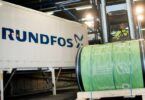Exclusive interview: H2O Global News editor Siôn Geschwindt caught up with Nick Dyner, CEO of Moleaer, to find about more about nanobubble technology, its myriad benefits, and how it can help the water industry on its journey to net zero.
The quantity of dissolved oxygen (DO) in water directly impacts its quality and its ability to support life. Just compare a fresh mountain stream to an algae-infested pond and the importance of DO becomes clear.
This is why a whole industry exists to provide aeration products and services – to keep water oxygen levels at or above a certain threshold.
But there is a new technology on the scene disrupting the norm and promising a host of other benefits too: nanobubbles.
Small is beautiful
Nanobubbles are tiny bubbles between 70-120 nanometers in size – 2500 times smaller than a single grain of salt.
Due to their microscopic size, they possess distinct properties from regular bubbles. They aren’t buoyant, they have a strong negative surface charge, and they release hydroxyl radical (HO) when they destabilise – a naturally-occuring oxidiser commonly used to destroy contaminants.
“These unique properties translate to notable water quality, water treatment, and efficiency benefits for a number of different industries,” said Nick Dyner, CEO of Moleaer, to H2O Global News.
Based in California and founded in 2017, Moleaer was born after its co-founder Bruce Scholten discovered a new method to produce billions of nanobubbles at an industrial scale.
The first company to bring nanobubble technology to market, Moleaer creates nanobubbles and uses machines to diffuse them into water supplies, sustaining the level of dissolved oxygen.
Dyner says the solution is far more effective than typical aeration technologies which generally achieve less than 3% oxygen transfer efficiency. This means that only a small fraction of the injected gas dissolves in the water – the rest bubbles up to the surface and is released back into the atmosphere.
However, Moleaer claims its proprietary technology is 30 times more efficient, enabling dissolved oxygen (DO) levels to increase while using far less oxygen.
This helps various sectors like agriculture and the water industry to reduce their water, chemical, and energy footprint, Dyner says.
Doing more, with less
Aeration alone makes up an estimated 70-80% of all energy consumed at a standard Wastewater Treatment Plant (WWTP).
This is because WWTPs clean water and remove contaminants primarily by circulating air to encourage the growth of beneficial bacteria.
The problem is that in the UK, for instance, WWTPs only source about 8.5% of their electricity from renewables.
Many water companies have committed to delivering a net zero water supply to customers by 2030. But in order to achieve this ambitious target they will need to come up with innovative ways to boost the efficiency of their processes.
The Fallbrook WWTP, California, was one such facility that faced challenges associated with inefficient aeration performance, largely due to the detrimental impacts of surfactants.
Surfactants reduce the surface tension of water and deplete oxygen levels – making typical aeration processes less effective. Typically 40-60% of the energy required to dissolve oxygen into wastewater can be attributed to the negative impacts of surfactants alone.
To tackle the issue, Fallbrook called in Moleaer. The company conducted two 25-day pilot studies using one of its nanobubble generators.
The nanobubbles were injected into a headworks basin upstream of the primary clarifiers to treat an average daily influent flow of 1.4 million gallons per day. Data on water quality and operating parameters, including dissolved oxygen (DO) and oxygen transfer efficiency, were measured throughout the pilot studies.

Moleaer’s nanobubble generator at Fallbrook Wastewater Treatment Plant
Third-party verified results showed that Moleaer’s nanobubble technology was able to reduce the organic and surfactant loads, resulting in an aeration energy savings that averaged 30% of the plant’s historical annual aeration expenditures. 60% more oxygen was transferred and 45% potential energy savings were made.
“The data collected showed how the adoption of the Moleaer nanobubble technology nearly doubled the energy efficiency of our existing fine-bubble aeration system, due to the ability of nanobubbles to remove surfactants from the influent wastewater,” said a Fallbrook WWTP representative.
These results are not isolated. Hundreds of use cases and several peer-reviewed studies show that nanobubbles can replace or improve the efficiency of water aeration processes.
Nanobubble technology will become ‘standard kit’ across many industries in the future
They also have a big role to play in agriculture, another industry that uses aeration technology extensively and also consumes a huge amount of water – 70% of the world’s total in fact.
“Nanobubbles cut costs for farmers, but they also oxygenate the water which brings higher crop yields and builds resilience in the root zone,” said Dryner. “This is proven to lower the water demand of plants – helping to reduce the water intake of agriculture.”
The benefits of nanobubbles are hard to deny, and clearly investors agree.
In May, Moleaer raised $40 million in a Series C funding round led by cleantech investors Apollo, bringing the company’s total funding raised to $61 million.
The company plans to use the fresh funding to ramp up every aspect of their business – from expanding their R&D lab to growing their international presence.
Dyner believes that nanobubble technology will become ‘standard kit’ across many industries in the future, driven by the demand for more efficient and sustainable solutions.
“If we are to mitigate and adapt to climate change, we need to start thinking about how to manage our water more effectively,” he added. “Nanobubbles just make sense – they are low risk and have so many benefits, and for this reason will no doubt be the go-to aeration technology of the future.”
Read more Moleaer Articles and News on H2O Global News. Do you have an article or video that you would like to share? Submit your article here or keep up with the latest news from the water industry and wastewater industry by subscribing to our weekly newsletter







